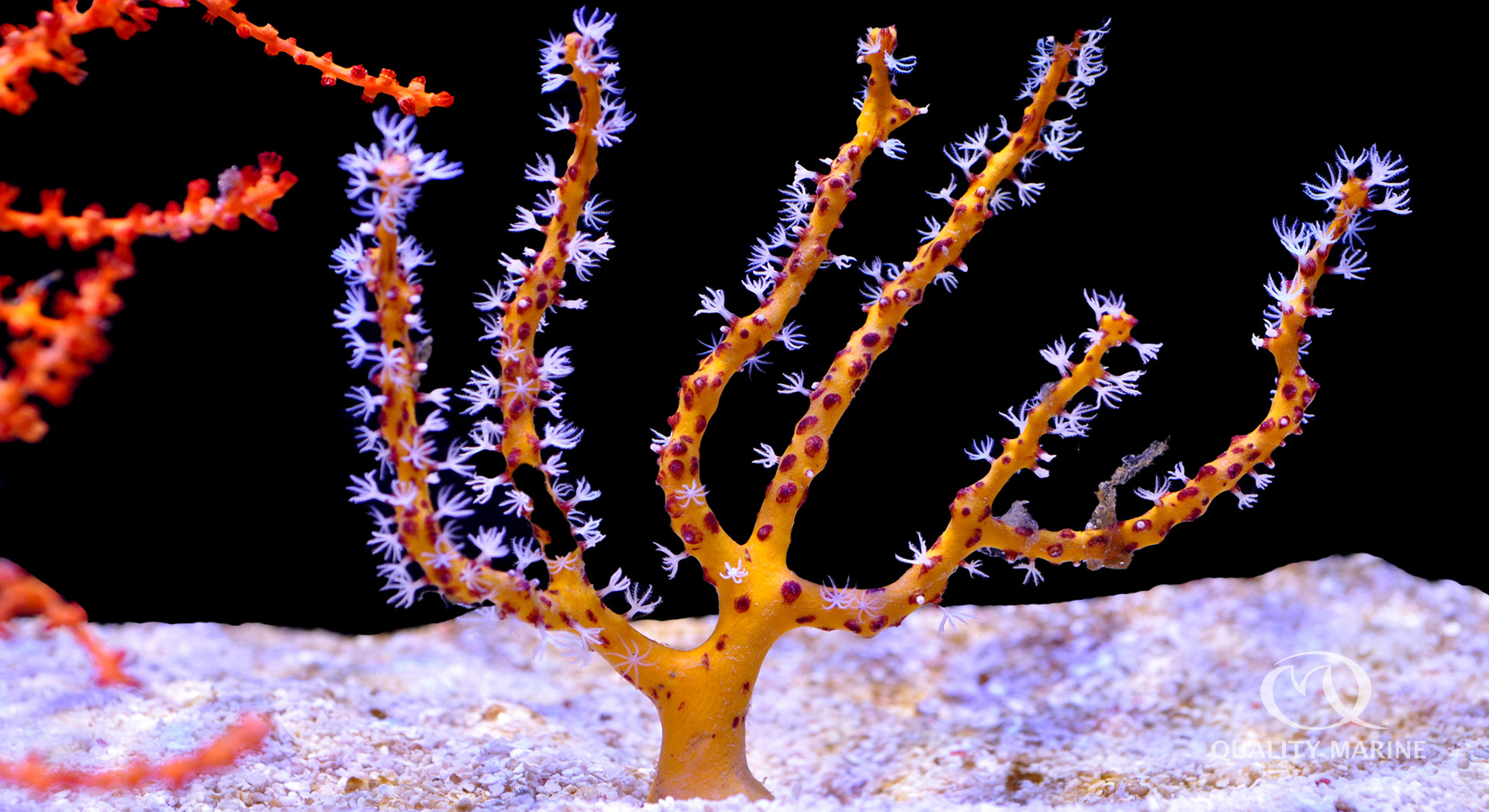Fingering Out Diodogorgia nodulifera

Diodogorgia nodulifera is a species of Gorgonian that is common throughout the tropical Caribbean. They generally seen in two different color morphs; bright red with white polyps and bright yellow with red and white polyps. Less frequently, orange variants pop up. They can be found at a variety of depths from as shallow as 30 feet down to a couple hundred. They can propagate sexually where male and female gametes are discharged into the water column and the fertilized eggs then drift on ocean currents. Perhaps more commonly this Gorgonian will reproduce asexually. They will “frag” themselves, meaning bits will break off, and will then be the start of a new colonies as long as they lodge somewhere suitable before being smashed to bits by current and rocks, or ground into the sand.
Gorgonians have long had a reputation for being difficult to keep in the home aquarium long term. This is really down to a few factors most of which are controllable by aquarists. The only one that isn't is the original condition of the animal itself. It's important to buy a Gorgonian that was shipped carefully, and was not held in bad conditions without food for any extended period of time. As long as you source your Diodogorgia nodulifera from Quality Marine, you can be assured that it has seen the most careful handling and shortest transport times possible. This isn't to say that there are not more challenges ahead for the aquarist who chooses to keep these (or indeed any Gorgonian) as they have specific needs and as such, we recommend them only for experienced aquarists who are up to the challenge of keeping things that require specialized care.
So how does one go about keeping Red or Yellow Finger Goronians healthy? Aquarium conditions are paramount to success. All gorgonians are non-photosynthetic. They do not need light, instead getting all of their nutrition from direct feeding and dissolved nutrients. Gorgonians are frequently burned by the intense lighting common in most reef aquariums. In addition, Finger Gorgonians are very susceptible to degrading when algae grows on them, which is more of a factor in brightly lit displays. When designing your aquarium to house these (or indeed any Gorgonian) either choose very subdued lighting, or build some some heavy shade into your rockscape or both. They will be much happier long term with very limited (or even no) direct light.
The next factor in the display that needs to be deliberately planned is the flow. Flow should be moderately strong, but never direct. Flow helps bring the animal food, and further helps prevent algae growth. Food and water quality are also paramount to success, and tied together. Water quality needs to be maintained at the highest level. Temperature and pH should be rock stable and trace nutrients need to be maintained through regular water changes or supplementation. If flow has been planned well, food will come to the Gorgonian naturally, but as an animal that gets nearly all of its nutritional needs from direct feeding, this amount of food will be insufficient for anything more than the shortest time frame. Direct feeding of appropriate foods will need to happen at least two to three times a week. Obviously more is better, as long there isn't so much feeding that it degrades water quality at all. Nutramar's line of live algae products are nothing short of a revolution when it comes to feeding Gorgonians. We use them in house with amazing success, and recommend them to all of the stores we work with. These foods can be further supplemented by dosing Nutramar's live copepods called Tigrio.
Another element to successfully keeping Diodogorgia nodulifera also comes down to display planning. What will you house your gorgonians with? Gorgonians are chemically and physically very peaceful with tankmates; they don't have much in the way of defense mechanisms and so almost anything you keep with the Gorgonian is likely to do well with it. Sadly, the reverse is not true. Gorgonians are best kept in aquariums without many other corals, or at least kept with ones that don't have long sweeper tentacles, or reputations for being chemically aggressive. Similarly, choosing other tankmates wisely will also help. Fish like Dwarf Angels that are known nippers find Gorgonian polyps irresistible, and will quickly remove this animal's only way to feed. Small fish that are peaceful eaters like dragonettes and seahorses make excellent tankmates. Planktivores like Anthias and Genicanthus Angels are also good choices as long as the filtration you have can keep water quality stable while taking care of their elevated food requirements.
As you've noticed thoughout the article, avoiding algae growth (and cyanobacteria growth) is one of the most important aspects of keeping Gorgonians. While you want to handle your Diodogorgia nodulifera as little as possible, physical removal of any algal or bacterial growth from them should happen as soon as it is noticed. Adjustments to the system should be made to help ensure this growth doesn't continue to happen.
If you're an experienced hobbyist, looking for an amazing display addition, and enjoy the technical aspects of advanced animal husbandry, keeping Diodogorgia nodulifera is definitely something you should pursue. Sourcing a quality specimen from us here at Quality Marine will start you off of the right foot. Ensure you've planned your display specifically for Gorgonians and take the proper steps to ensure it gets enough food, stock up on Nutramar's live algae products and you are well on your way to successfully keeping one of the most beautiful sessile creatures in marine aquarium keeping. Ask your LFS about getting you a Red or Yellow Finger Gorgonian from Quality Marine today!